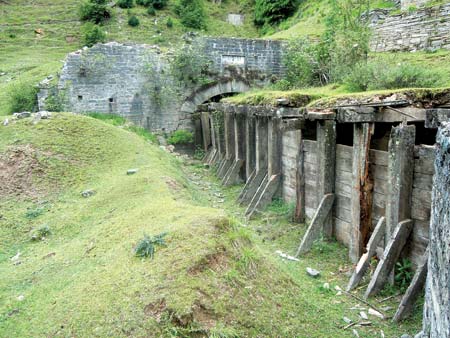Kashmir was inundated by a great flood in 1903. Jhelum flowed down with such a huge discharge that parts of M A Road remained water logged for many years. Historian P N K Bamzai offers details of the flood in his ‘Socio-Economic History of Kashmir 1846-1925’. Saima Rashid copied the chapter for Kashmir Life readers

History alas, repeated itself within so short a period as ten years. The Resident in Kashmir in his telegram dated 17th July, 1903, reported to the viceroy that heavy floods in the Jhelum equal to that of 1893 were approaching the city. The spill channel dug a few years earlier was behaving well and it was due to it that Srinagar was not inundated till then. On July 23, the greatest flood ever known came down the valley of Kashmir on Srinagar, and by 10’o clock that day the whole of the ground covered by the European settlement, as well as the flanks of the city, was converted into a huge Lake.
Measurement showed that the water level was higher by 3 feet than the flood of 1893. The Bund protecting the Dal or City Lake was also breached near the flood gates, the water rising to 10 feet above the high level, and inflicting immensed injury to floating gardens, houses, etc. Seven thousand dwellings went down in the neighbourhood of the city, including 773 on the Dal Lake, compared with 1893, the damage to bridges was small. Only those at Khanabal and Baramulla (which later had weathered the flood of 1893) were swept away. In the Munshi Bagh, the old library, the barracks, two of the older houses and two in the Hari Singh Bagh were destroyed. The Residency, Nedous’ Hotel, all houses and offices had upwards of five feet of water in their ground-floors and people stepped out of the hotel verandah into boats. The church, with a very low plinth, suffered much the water covering the lamps chandeliers, and the only the roof being visible from the outside.
Flood Protection Measures
The expansion of Srinagar had started with the beginning of the present century in a haphazard way. The low-lying land towards the south and developed into Civil lines there were European shops and hutments. The flood of 1903 swept away this locality and the Resident, Sir Luis Dane, decided to undertake flood protection measures on a long term basis. The State Engineer, Major A.de Lotbiniere were detailed to prepare a comprehensive scheme in this respect. After a survey of several months they submitted their note and chief recommendations.
These Engineers seemed to have followed strictly the measures taken by Suyya 1200 years ago. They recommended that to give a quicker and a wider outlet to the flood waters of the valley, the bed of the river from the Wular Lake to Baramulla be depended and widened. This was to be done by dredgers to be run by electric power which the engineers proposed to generate at Mahoora sixteen miles lower down. It is interesting to know that originally this power house which later on supplied electricity to the city was meant exclusively for dredging operations.

Another important recommendation of the engineers was to widen the spill channel from above Srinagar to a point 15 miles below it towards west. This they thought would carry a large amount of flood waters and would definitely help in saving the city from destruction.
In 1905-06 the machinery required for the hydro-electric generating plant at Mahora and the dredgers for depending of the bed of the river at Baramulla were ordered from America. The Mahora power house was completed by the end of 1907. Incidentally it may be represented here that it was the second hydroelectric project then in India, the first one being in Mysore.
Dredging operations began in 1908 and by 1912 an area of 6,110 acres was reclaimed from around the Wular Lake. It was allotted to cultivators for paddy cultivation. The official report on dredging dated 13th July, 1911, mentioned that since the operations began two years earlier, the level of the Jhelum was considerably reduced; the velocity of the current between Sopore and Baramulla had been largely increased resulting in much greater discharge of the river. But the maintenance charges of the dredges and the replacement of their worn out parts was a big drain on the slender resources of the state.
Fortunately for the valley there were no major floods for a quarter of a century. The dredging operations, though valuable in their own way, were looked down upon by the State as useless expenditure and in 1917 the dredgers were sold as junk. The result was that the old story of silting up of the river bed in the Wular Lake was repeated and when in 1928 there was a flood towards the end of August, the low-lying parts of the city of Srinagar which had to then extended to a larger area were inundated and destruction was caused to the standing crops. Again the state government woke up to taking flood production measures, but instead of having a long term view of the problem, they started again to build high bunds round the low-lying parts of Srinagar—the chief aim being to save the city at the cost of the rest of the valley.















